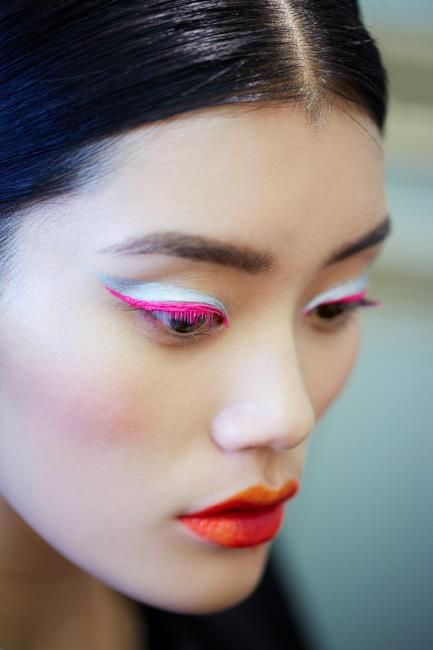Pat McGrath, ph Steven Meisel
Short Biography
Pat McGrath is born in 1970. She was raised by her mother, Jean McGrath, a Jamaican immigrant, in Northampton. Pat didn’t have a formal training as a make-up artist, but she did become one of the most influential ones in the fashion industry.
Pat says her mother, who was a keen follower of fashion, is the one who stimulated her creativity.The two made a habit of studying classic Hollywood films, which Pat cites as a key to her ultimate success . Jean would quiz her daughter on different shades of eye shadow. “She trained me, basically, to do the shows, right there… look at the pattern, check the fabrics, look for the make-up – and begin.” “She was always mixing up colours because there wasn’t anything out there for black skin.”
She has described her upbringing as “very religious, very conservative” and has spoken of her teenage fascination with the Blitz Kids – Boy George, Marilyn, Spandau Ballet – all of whom were famed for their outré make-up and whom she used to follow around the King’s Road. “We thought we were New Romantics, we’d get changed on the train and try to get into all those clubs,” she told the Guardian in 2008.
After leaving school, Pat completed an art foundation course at Northampton College. She had planned to undertake a fashion degree but abandoned this when she met the stylist Kim Bowen, who invited her along to watch her work on shoots for The Face and i-D. Her big break came when she received a phone call asking her to go on tour in Japan with Caron Wheeler from Soul II Soul, whose make-up she had done one afternoon three years previously as a favour for a friend. “I left my job and went to Japan for three months, scared to death. I cried all the way there because I’d never been on a plane before and I was terrified.” This opportunity led to McGrath working with i-D magazine’s fashion director Edward Enninful and subsequently, being named beauty director for the title – a position which she holds to this day.
The drama of Pat’s work is a reflection of her larger-than-life personality. She can create fantasy at the drop of a hat and is known for arriving backstage armed with at least 20 cases of ammunition, from standard-issue mascara to sequins, doilies, and art books.
Additionally, she designed Armani’s cosmetics line in 1999 and in 2004, and in 2009 for Dolce & Gabbana, was named global creative-design director for Procter and Gamble, where she is in charge of Max Factor and Cover Girl cosmetics, among other brands.
In the 2013 Queen Elizabeth II’s New Year Honors List,Pat McGrath was “named an MBE, or Member of the Order of the British Empire, for services to the fashion and beauty industry.”
“Everything goes into fashion, it isn’t just makeup. . . . It’s film, TV, history of art, books, clubs. The culture.”
..
.
.
.
Lisbeth Salander
Pat McGrath also designed the makeup for “The Girl with the Dragon Tattoo”,Lisbeth Salander, one of my favorite movie characters and transition: to make the porcelain-faced Rooney Mara into a stone-cold punk computer hacker, her eyebrows were bleached and her hair dyed black. It made her become this dark, androgynous, and mysterious loner.
Rooney Mara
Keeping the look minimal, as a real tomboy would, Pat focused mainly on shaping the eyes with smoky shadow and bare skin (“There was no foundation. I wanted her skin to be translucent and for it to change color in the cold. In fact, the most beautiful scene is when she was actually very cold.”) The trick was to take black and brown eye colors and add a tiny drop of red—that created a look that was vulnerable but hard and strong.
.
.
.
 Pat McGrath & Anna Piaggi
Pat McGrath & Anna Piaggi
info: Vogue UK & Voguepedia
























One Response to “Pat McGrath, “The most influential make-up artist in the world””